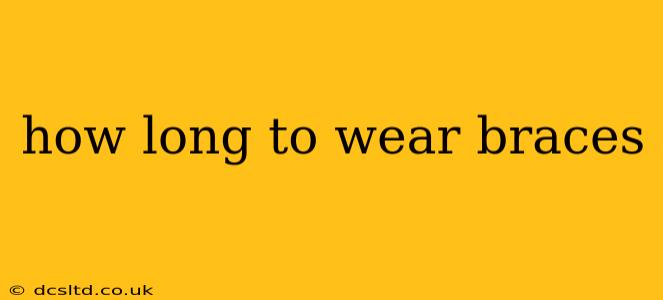The burning question for many orthodontic patients: how long will I have to wear braces? There's no single, simple answer, as treatment time depends on several factors. This comprehensive guide explores the variables influencing treatment length and provides a realistic expectation of the overall timeframe.
What Factors Determine Braces Treatment Time?
Several key elements contribute to the duration of your orthodontic treatment. These include:
-
Severity of the misalignment: Mild crowding or spacing typically requires less treatment time than severe malocclusion (improper bite). Significant jaw discrepancies or complex bite problems will naturally extend the treatment period.
-
Patient's age: Younger patients often respond more quickly to orthodontic treatment than adults. Bone is more malleable in younger individuals, leading to faster tooth movement.
-
Cooperation and compliance: Diligent adherence to the orthodontist's instructions, including regular appointments and meticulous oral hygiene, significantly impacts treatment success and speed. Missed appointments or neglecting oral care can lead to delays.
-
Type of braces: While traditional metal braces remain effective, newer technologies like Invisalign aligners or lingual braces can sometimes impact treatment timelines. The specific type of brace used will influence the duration of treatment.
-
Overall health: Underlying health conditions can affect treatment response. Certain medical issues might require adjustments to the treatment plan or impact the speed of tooth movement.
How Long is "Average"? Understanding Treatment Time Ranges
While individual experiences vary greatly, a reasonable estimate for braces treatment time is between 18 to 30 months. This range encompasses most orthodontic cases.
-
Shorter treatment times (12-18 months): These are often seen in cases of mild misalignment in younger patients with excellent cooperation.
-
Longer treatment times (30 months or more): More complex cases, such as severe malocclusion, significant jaw discrepancies, or cases requiring extractions, often necessitate a longer treatment period.
It's crucial to remember that this is just a guideline. Your orthodontist will provide a personalized treatment plan and timeframe based on your specific needs and circumstances.
What Happens After Braces Removal?
The journey doesn't end when the braces come off! A crucial phase involves wearing a retainer. Retainers are essential for maintaining the achieved results and preventing teeth from shifting back to their original positions. The length of retainer use also varies, often ranging from several months to years, depending on individual cases.
How long do I need to wear a retainer?
This is a critical question often overlooked. Your orthodontist will recommend a specific retainer schedule tailored to your individual needs. This typically involves wearing a retainer full-time initially, gradually transitioning to nighttime wear for long-term stability. Non-compliance can lead to relapse, undoing the progress achieved with braces.
What if my teeth shift after braces?
Relapse, unfortunately, is a possibility. Failure to wear the retainer as instructed can allow teeth to shift. While not always entirely preventable, consistent retainer use minimizes this risk. If relapse occurs, further orthodontic intervention might be required.
Can I get Invisalign instead of traditional braces?
Invisalign is an alternative to traditional braces, utilizing clear aligners to gradually straighten teeth. Treatment time with Invisalign can be comparable to traditional braces, depending on the complexity of the case. Your orthodontist can advise whether Invisalign is suitable for your specific situation.
What is the best age to get braces?
There isn't a single "best" age. Orthodontic treatment can be beneficial at various ages, from childhood to adulthood. Early intervention can sometimes prevent more extensive treatment later on, while adult treatment can significantly improve both oral health and aesthetics.
Are there any risks associated with braces?
While generally safe, some potential risks associated with braces include discomfort, temporary mouth sores, and a slight increased risk of cavities if oral hygiene isn't meticulously maintained. These are typically minor and manageable with proper care. Your orthodontist will address any concerns during your consultation.
The Bottom Line: Consult Your Orthodontist
The best way to determine how long you will need braces is to consult with a qualified orthodontist. They will conduct a thorough examination, assess your specific needs, and develop a personalized treatment plan, including a realistic timeframe. Open communication with your orthodontist throughout the process ensures you're well-informed and prepared for every stage of treatment.
